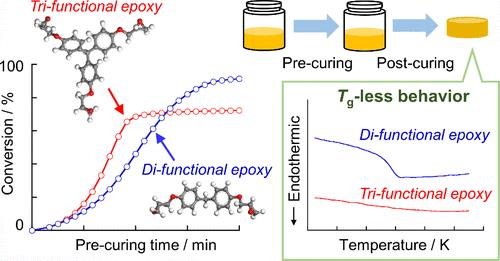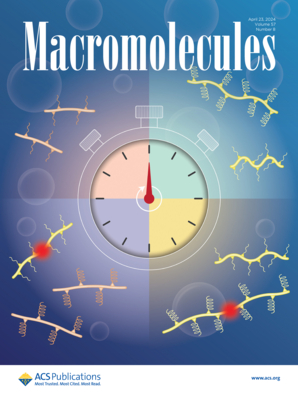环氧官能团数量密度对环氧树脂反应动力学的影响
IF 5.1
1区 化学
Q1 POLYMER SCIENCE
引用次数: 0
摘要
提高环氧树脂的耐热性在各种应用中仍然是一个重要而又具有挑战性的问题。应对这一挑战的策略之一是设计基于多功能环氧树脂的固化树脂。与传统的双官能环氧树脂相比,多功能环氧树脂有望轻松形成高度交联结构,从而有助于增强耐热性。然而,关于这种交联结构形成的详细机制及其对物理性能的影响,目前还缺乏相关信息。在此,我们对双官能环氧树脂和三官能环氧树脂与胺固化剂的固化反应动力学进行了跟踪研究。尽管两种基础单体中环氧基团的反应活性相同,但三官能环氧体系的固化速度更快。此外,在双官能环氧体系中,凝胶化随后发生玻璃化,而在三官能环氧体系中,凝胶化和玻璃化同时发生。在三官能环氧体系中观察到的加速固化反应可以用反应热导致的局部温度升高来解释,温度升高会加速接下来的反应。由此产生的后固化三官能环氧树脂没有表现出明显的玻璃化转变。这种所谓的无 Tg 行为是由于三官能环氧单元的玻璃化温度高于其分解温度。这种无 Tg 行为的机理与加速固化反应相结合,为设计热稳定性更强的热固性树脂提供了宝贵的启示。本文章由计算机程序翻译,如有差异,请以英文原文为准。

Effect of Number Density of Epoxy Functional Groups on Reaction Kinetics for Epoxy Resin
Improving the heat resistance of epoxy resins remains an important and challenging issue across a wide variety of applications. One strategy to address this challenge is the design of cured resins based on multifunctional epoxy. Compared to conventional difunctional epoxy resins, multifunctional epoxy resins are expected to easily form a highly cross-linking structure, which is anticipated to contribute to enhanced heat resistance. However, there is a lack of information about the detailed mechanisms of the formation of such cross-linking structures and their effects on the physical properties. We herein tracked the kinetics of curing reactions of difunctional and trifunctional epoxies with an amine hardener. Despite the identical reactivity of epoxy groups in both base monomers, the trifunctional epoxy system cured faster. In addition, in the difunctional epoxy system, gelation was followed by vitrification, while in the trifunctional epoxy system, gelation and vitrification occurred simultaneously. The accelerated curing reaction observed in the trifunctional epoxy system could be explained in terms of the localized temperature increase from the reaction heat, which subsequently accelerated the following reactions. The resulting post-cured trifunctional epoxy resin did not exhibit a clear glass transition. This, so-called Tg-less behavior was due to the glass transition temperature of the trifunctional epoxy unit being higher than its decomposition temperature. This mechanism for the Tg-less behavior, combined with the accelerated curing reactions, provides valuable insights for the design of thermosetting resins with enhanced thermal stability.
求助全文
通过发布文献求助,成功后即可免费获取论文全文。
去求助
来源期刊

Macromolecules
工程技术-高分子科学
CiteScore
9.30
自引率
16.40%
发文量
942
审稿时长
2 months
期刊介绍:
Macromolecules publishes original, fundamental, and impactful research on all aspects of polymer science. Topics of interest include synthesis (e.g., controlled polymerizations, polymerization catalysis, post polymerization modification, new monomer structures and polymer architectures, and polymerization mechanisms/kinetics analysis); phase behavior, thermodynamics, dynamic, and ordering/disordering phenomena (e.g., self-assembly, gelation, crystallization, solution/melt/solid-state characteristics); structure and properties (e.g., mechanical and rheological properties, surface/interfacial characteristics, electronic and transport properties); new state of the art characterization (e.g., spectroscopy, scattering, microscopy, rheology), simulation (e.g., Monte Carlo, molecular dynamics, multi-scale/coarse-grained modeling), and theoretical methods. Renewable/sustainable polymers, polymer networks, responsive polymers, electro-, magneto- and opto-active macromolecules, inorganic polymers, charge-transporting polymers (ion-containing, semiconducting, and conducting), nanostructured polymers, and polymer composites are also of interest. Typical papers published in Macromolecules showcase important and innovative concepts, experimental methods/observations, and theoretical/computational approaches that demonstrate a fundamental advance in the understanding of polymers.
 求助内容:
求助内容: 应助结果提醒方式:
应助结果提醒方式:


